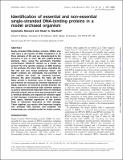Files in this item
Identification of essential and non-essential single-stranded DNA-binding proteins in a model archaeal organism
Item metadata
| dc.contributor.author | Skowyra, Agnieszka | |
| dc.contributor.author | MacNeill, Stuart | |
| dc.date.accessioned | 2012-03-08T16:31:12Z | |
| dc.date.available | 2012-03-08T16:31:12Z | |
| dc.date.issued | 2012-02-01 | |
| dc.identifier | 15326558 | |
| dc.identifier | f6e15d51-8ee9-4a58-be91-fd6352af14b2 | |
| dc.identifier | 84856830977 | |
| dc.identifier | 000300422400021 | |
| dc.identifier.citation | Skowyra , A & MacNeill , S 2012 , ' Identification of essential and non-essential single-stranded DNA-binding proteins in a model archaeal organism ' , Nucleic Acids Research , vol. 40 , no. 3 , pp. 1077-1090 . https://doi.org/10.1093/nar/gkr838 | en |
| dc.identifier.issn | 0305-1048 | |
| dc.identifier.other | ORCID: /0000-0002-0555-0007/work/39107868 | |
| dc.identifier.uri | https://hdl.handle.net/10023/2414 | |
| dc.description | This work is supported by the The Scottish Universities Life Sciences Alliance (SULSA) | en |
| dc.description.abstract | Single-stranded DNA-binding proteins (SSBs) play vital roles in all aspects of DNA metabolism in all three domains of life and are characterized by the presence of one or more OB fold ssDNA-binding domains. Here, using the genetically tractable euryarchaeon Haloferax volcanii as a model, we present the first genetic analysis of SSB function in the archaea. We show that genes encoding the OB fold and zinc finger-containing RpaA1 and RpaB1 proteins are individually non-essential for cell viability but share an essential function, whereas the gene encoding the triple OB fold RpaC protein is essential. Loss of RpaC function can however be rescued by elevated expression of RpaB, indicative of functional overlap between the two classes of haloarchaeal SSB. Deletion analysis is used to demonstrate important roles for individual OB folds in RpaC and to show that conserved N- and C-terminal domains are required for efficient repair of DNA damage. Consistent with a role for RpaC in DNA repair, elevated expression of this protein leads to enhanced resistance to DNA damage. Taken together, our results offer important insights into archaeal SSB function and establish the haloarchaea as a valuable model for further studies. | |
| dc.format.extent | 14 | |
| dc.format.extent | 3914341 | |
| dc.language.iso | eng | |
| dc.relation.ispartof | Nucleic Acids Research | en |
| dc.subject | QH426 Genetics | en |
| dc.subject.lcc | QH426 | en |
| dc.title | Identification of essential and non-essential single-stranded DNA-binding proteins in a model archaeal organism | en |
| dc.type | Journal article | en |
| dc.contributor.institution | University of St Andrews. School of Biology | en |
| dc.contributor.institution | University of St Andrews. Biomedical Sciences Research Complex | en |
| dc.identifier.doi | 10.1093/nar/gkr838 | |
| dc.description.status | Peer reviewed | en |
This item appears in the following Collection(s)
Items in the St Andrews Research Repository are protected by copyright, with all rights reserved, unless otherwise indicated.

